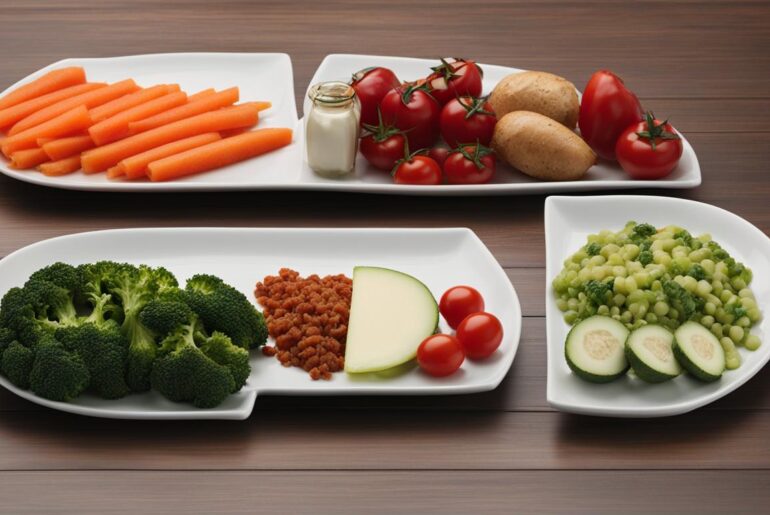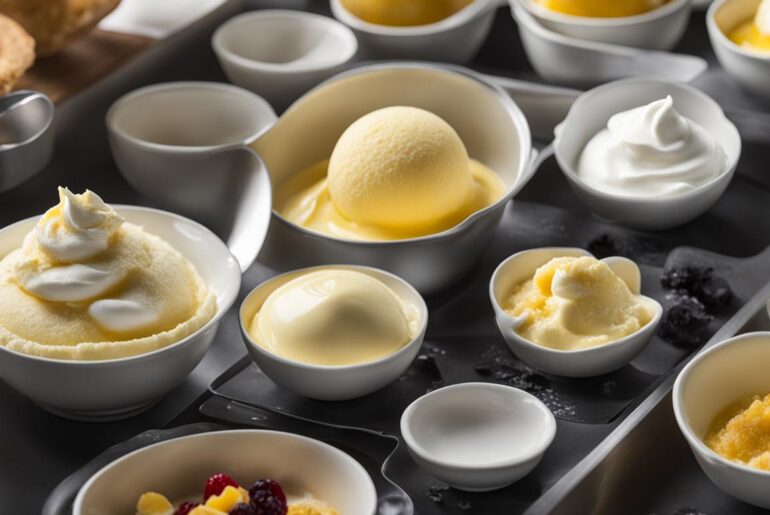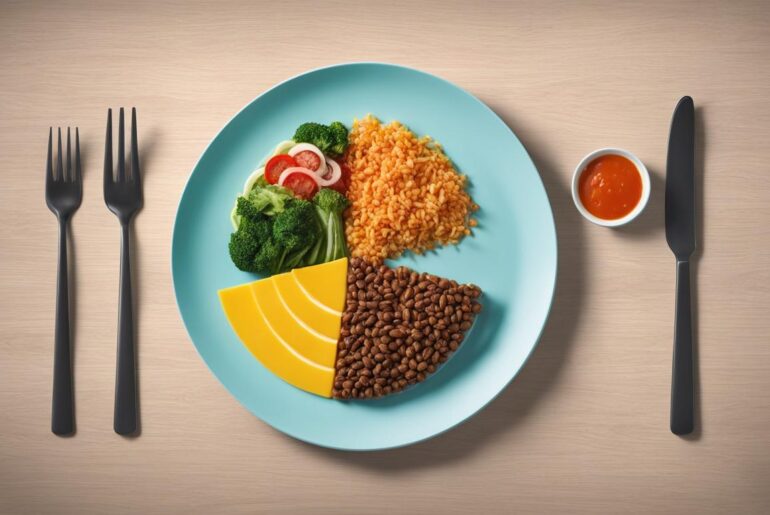Maintaining a healthy diet can be a challenge for busy individuals who are constantly juggling multiple responsibilities. However, implementing effective portion control strategies can help busy individuals manage their portion sizes and prioritize their eating habits, even with their hectic schedules (check out my post on portion control strategies here). In this article, I will explore various portion control techniques and tips specifically tailored for busy individuals (check this post out).
By incorporating these portion control strategies into their daily routine, busy individuals can ensure that they consume appropriate amounts of food to fuel their busy lifestyles and maintain a healthy weight. Let’s dive into the world of portion control and discover how it can revolutionize your eating habits.
Key Takeaways:
- Implementing portion control strategies is crucial for busy individuals to prioritize healthy eating habits (check this post out).
- Portion control helps individuals manage their portion sizes, prevent overeating, and promote a balanced diet.
- Using smaller plates, measuring cups, and being selective with seconds are effective portion control techniques for busy individuals.
- Understanding energy density and making smart food choices can further enhance portion control efforts.
- Portion control is not only beneficial for weight loss but also for weight management and overall well-being.
Importance of Portion Control for Busy Individuals
Establishing healthy eating habits and managing portion sizes is crucial for busy individuals (check this post out). Due to their hectic schedules, it can be challenging for them to prioritize healthy eating. However, by practicing portion control, they can ensure that they consume appropriate amounts of food, maintain a healthy weight, and have enough energy to fuel their busy lifestyles.
Portion control plays a significant role in promoting healthy eating habits by encouraging individuals to be mindful of their food intake and make conscious choices. By being aware of portion sizes, busy individuals can avoid overeating and make more balanced meal decisions.
“Portion control is not about deprivation, but rather about maintaining a healthy relationship with food and nourishing your body with the right amounts.”
Implementing portion control helps individuals maintain a balanced diet by ensuring they consume all the necessary nutrients in the right proportions. When individuals have limited time to prepare meals or rely on convenience options, portion control can help them make healthier choices and avoid excessive calorie intake.
Additionally, portion control can prevent the negative consequences of overeating, such as weight gain and digestive discomfort. By managing portion sizes, busy individuals can maintain a healthy weight and reduce the risk of obesity-related health issues.
Overall, adopting portion control as part of a busy lifestyle is essential for promoting overall well-being and sustaining healthy eating habits. It allows individuals to enjoy a variety of foods while maintaining a moderate caloric intake and maximizing nutrition.
Benefits of Portion Control for Busy Individuals:
- Ensures appropriate food consumption for busy individuals
- Maintains a healthy weight
- Prevents overeating and promotes a balanced diet
- Sustains healthy eating habits
| Portion Control Tips for Busy Individuals | Description |
|---|---|
| Use smaller plates and bowls | Using smaller tableware can help control portion sizes and prevent overeating. |
| Measure portion sizes | Invest in measuring cups and a kitchen scale to accurately measure portion sizes. |
| Plan and pack meals in advance | Preparing meals ahead of time allows busy individuals to control portion sizes and make healthier choices. |
| Avoid eating straight from the package | Portion out snacks and meals onto a plate or bowl to avoid mindlessly overeating. |
| Practice mindful eating | Eating slowly, savoring each bite, and paying attention to hunger and fullness cues can help prevent overeating. |
Portion Control Strategies for Busy Individuals
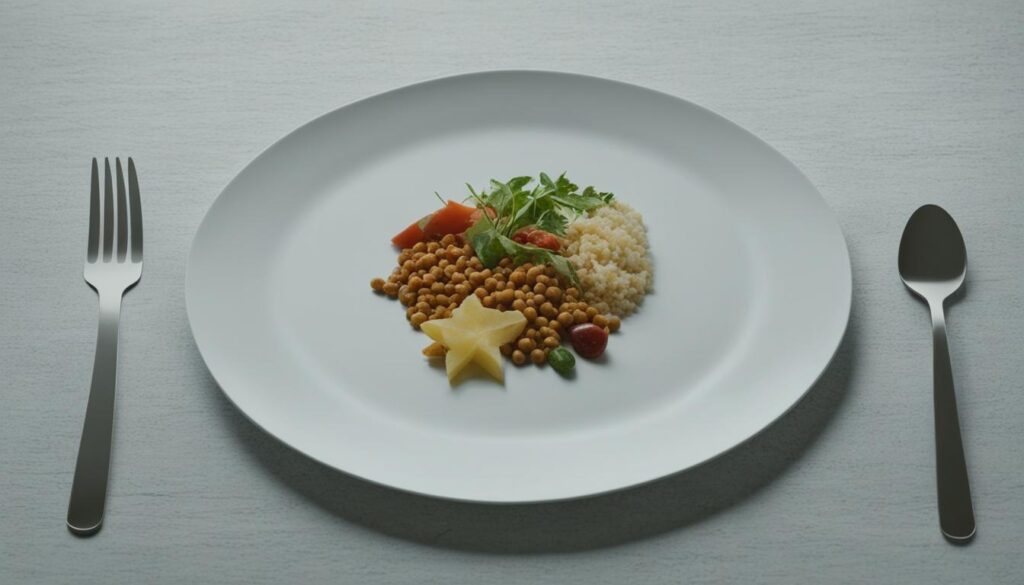
As a busy individual, managing food intake can be challenging, but implementing effective portion control strategies can make a significant difference. By being mindful of portion sizes and making smart choices, busy individuals can maintain a healthy diet even with a hectic lifestyle. Here are some practical portion control techniques and tips:
1. Use Smaller Plates
Opt for smaller plates when serving meals. Research shows that using smaller plates can trick the mind into feeling satisfied with less food, helping to control portion sizes [1].
2. Measure with Measuring Cups
Utilize measuring cups or a kitchen scale to accurately portion out foods. This helps prevent overeating and ensures that you’re consuming appropriate portions [2].
3. Be Selective with Seconds
Avoid automatically reaching for seconds. Give yourself time to assess if you’re genuinely still hungry or simply eating out of habit [3].
4. Avoid Picking At Leftovers
Resist the urge to snack on leftover food while preparing or cleaning up. These unplanned bites can add up and disrupt portion control efforts [4].
5. Implement the 20-Minute Rule
Wait at least 20 minutes after finishing a meal before considering seconds. It takes time for our stomachs to signal to our brains that we’re full, so giving yourself a break can help prevent overeating [5].
6. Check Food Labels
Read food labels to understand appropriate portion sizes. Pay attention to serving sizes and the number of servings per package to ensure you’re consuming the intended portions [6].
7. Ask for Smaller Portions When Eating Out
Don’t hesitate to request smaller portion sizes when dining at restaurants. Many establishments are willing to accommodate, helping you maintain control over your food intake [7].
Quick Meal Ideas and Healthy Meal Planning
Incorporating quick meal ideas and healthy meal planning into your routine can greatly assist with portion control. By preparing nutritious meals in advance, you can portion out appropriate serving sizes and have balanced meals readily available.
Here’s an example of a simple and healthy meal plan for a busy week:
| Day | Breakfast | Lunch | Dinner | Snack |
|---|---|---|---|---|
| Monday | Avocado Toast | Quinoa Salad | Grilled Chicken with Roasted Vegetables | Greek Yogurt with Berries |
| Tuesday | Fruit Smoothie | Spinach and Feta Wrap | Salmon with Brown Rice and Steamed Broccoli | Carrot Sticks with Hummus |
| Wednesday | Oatmeal with Nuts and Berries | Chicken Caesar Salad | Vegetable Stir-Fry with Tofu | Almonds |
| Thursday | Egg and Vegetable Scramble | Turkey and Avocado Wrap | Whole Wheat Pasta with Marinara Sauce and Grilled Shrimp | Apple Slices with Peanut Butter |
| Friday | Yogurt Parfait with Granola | Mediterranean Quinoa Salad | Grilled Steak with Sweet Potato and Steamed Asparagus | Trail Mix |
Remember, portion control is a valuable tool that can help busy individuals maintain a healthy and balanced diet. By implementing these strategies and incorporating quick meal ideas into your routine, you can achieve your health and wellness goals even with a busy schedule.
Energy Density and Portion Control
Understanding energy density is crucial when it comes to effective portion control. Energy-dense foods, which are high in fat and/or sugar, can lead to excessive calorie intake and hinder weight management efforts. On the other hand, choosing less energy-dense foods can help individuals control their portion sizes without sacrificing satisfaction.
When referring to energy density, we are considering the number of calories per gram of food. High energy density foods, such as deep-fried snacks and sugary treats, often pack a significant amount of calories in a small portion. In contrast, low energy density foods, like fruits, vegetables, and whole grains, contain fewer calories per gram. By incorporating these foods into the diet, individuals can consume larger portions without consuming excessive calories.
Here are some examples of smart swaps that can help manage energy density and portion control:
“Choosing plain popcorn over crisps.”
“Opting for fresh berries over a calorie-dense berry muffin.”
By making these simple adjustments, individuals can satisfy their taste buds while controlling their calorie intake. Enjoying nutrient-dense, low energy density foods provides a greater volume of food, making it easier to stay satisfied and maintain portion control.
Incorporating these food swaps into daily meals can have a significant impact on weight management. The table below illustrates the energy density of various food categories to guide individuals in making informed choices:
| Food Category | Energy Density |
|---|---|
| Fruits and vegetables | Low |
| Lean proteins (chicken, fish, tofu) | Low |
| Whole grains (brown rice, quinoa) | Low |
| Dairy products (low-fat milk, yogurt) | Medium |
| Fatty meats and processed meats | High |
| Sugary snacks, desserts, and pastries | High |
As demonstrated in the table, foods with low energy density, such as fruits, vegetables, lean proteins, and whole grains, are ideal choices for portion control and weight management. Meanwhile, high energy density foods, like fatty meats and sugary snacks, should be consumed in moderation.
Portion Control and Weight Loss
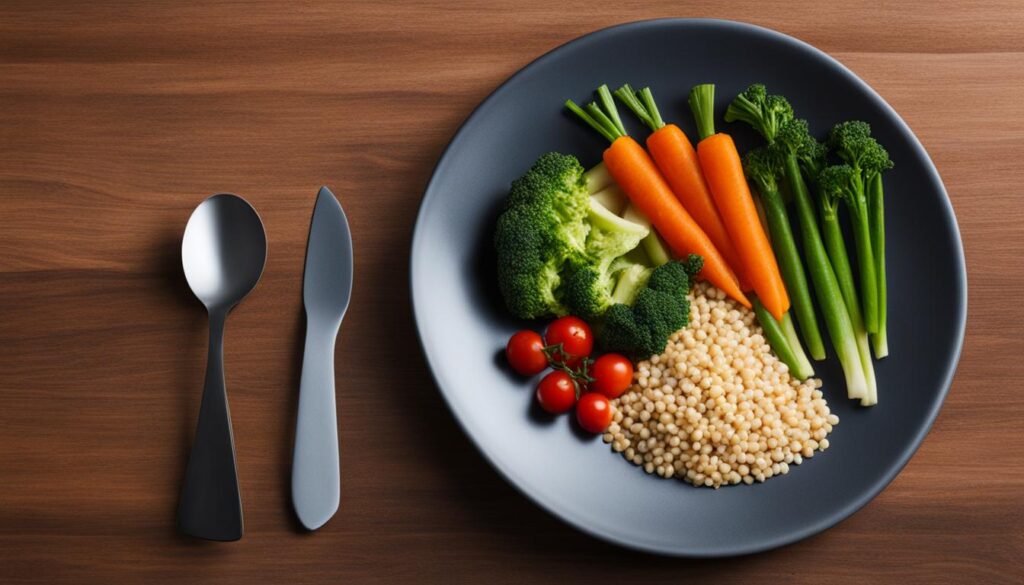
When it comes to weight loss and weight management, portion control is a powerful tool. By carefully managing portion sizes and making mindful food choices, individuals can create a calorie deficit necessary for sustainable weight loss. This means consuming fewer calories than the body needs, leading to the utilization of stored fat for energy.
Portion control not only helps individuals in their weight loss journey but also plays a vital role in maintaining a moderate weight once the desired goals are achieved (see my post here). By practicing portion control, individuals can prevent overeating and ensure that they stay within their recommended caloric intake. This is essential for maintaining a healthy balance and preventing weight regain.
To support portion control for weight loss, individuals can utilize various strategies. Portion control plates, for example, are designed to guide individuals in portioning their meals appropriately. These plates often have labeled sections indicating ideal portions of proteins, carbohydrates, and vegetables, helping individuals visualize balanced meals. Keeping a food diary can also be a useful strategy, allowing individuals to track portion sizes and monitor their progress.
It is important to note that portion control is not about depriving oneself of favorite foods. Instead, it is about enjoying them in moderation and being mindful of portion sizes. By understanding the nutritional value and energy density of different foods, individuals can make informed choices that align with their weight loss goals.
Remember, weight loss is a gradual process that requires consistency and patience. Incorporating portion control into your lifestyle can help you achieve long-term success while still enjoying a variety of foods.
The Role of Exercise
In addition to portion control, regular physical activity is essential for weight loss and overall health. Engaging in aerobic exercise and strength training can help individuals burn calories, build lean muscle mass, and boost metabolism. Incorporating exercise into your daily routine, along with portion control, can optimize weight loss efforts and contribute to the maintenance of a moderate weight.
Summary
Portion control is a valuable strategy for weight loss and weight management. By managing portion sizes, choosing appropriate foods, and maintaining an active lifestyle, individuals can create a calorie deficit, achieve sustainable weight loss, and maintain a moderate weight over time.
| Key Benefits of Portion Control for Weight Loss | Example Strategies for Portion Control |
|---|---|
| Creates a calorie deficit necessary for weight loss | Using smaller plates and bowls |
| Prevents overeating | Measuring portion sizes with measuring cups or a food scale |
| Maintains a balanced and nutritious diet | Being mindful of high-calorie condiments and dressings |
| Supports long-term weight management | Keeping a food diary to track portion sizes and progress |
Tips for Successful Portion Control
Successful portion control requires implementing various tips and techniques. By incorporating these strategies into your daily routine, you can effectively manage your portion sizes and maintain a balanced diet.
1. Use Smaller Plates, Utensils, and Crockery
To control portion sizes, opt for smaller plates, utensils, and crockery. This visual trick can make your food portions appear larger, leading to a sense of satisfaction even with smaller amounts.
2. Prioritize Nutrient-Dense Foods
Choose foods that are nutrient-dense, meaning they provide a high amount of essential nutrients and are relatively low in calories. Incorporate a variety of fruits, vegetables, whole grains, lean proteins, and healthy fats into your meals to ensure that you are getting the necessary nutrients while controlling your portion sizes.
3. Stay Hydrated by Drinking Water
Drinking an adequate amount of water throughout the day can help control your appetite and prevent overeating. Aim to consume at least 8 cups (64 ounces) of water per day, or more if you engage in physical activity or live in a hot climate.
4. Chew Food Effectively and Eat at a Slower Pace
Take the time to chew your food thoroughly and eat at a slower pace. This allows your body to recognize when you are full and prevents overeating. Eating mindfully and savoring each bite can also enhance your overall dining experience.
5. Increase Meal Frequency
Instead of consuming three large meals, try eating smaller, more frequent meals throughout the day. This approach can help control hunger and cravings, while also boosting your metabolism. Aim to eat every 3-4 hours and include a balanced mix of protein, carbohydrates, and healthy fats in each meal.
6. Keep a Food Diary
Maintaining a food diary can help you track your portion sizes, monitor your calorie intake, and identify any areas where you may be overeating. This self-reflection tool can increase your awareness of your eating habits and enable you to make necessary adjustments for successful portion control.
By implementing these portion control techniques and incorporating them into your daily routine, you can achieve your weight management goals and maintain a healthy diet. Remember, successful portion control is about balance and mindful eating.
Conclusion
In conclusion, efficient portion control strategies are crucial for busy individuals to maintain a healthy diet and manage their weight. By implementing portion control techniques such as using smaller plates, measuring cups, and being selective with seconds, busy individuals can ensure that they consume appropriate amounts of food to fuel their busy lifestyles.
Portion control not only helps with weight management but also promotes healthy eating habits and balanced nutrition. By being mindful of portion sizes and making conscious food choices, individuals can achieve their weight management goals while still enjoying their favorite foods.
With these strategies in place, busy individuals can maintain a healthy diet and achieve long-term success in managing their weight. By incorporating portion control into their daily routine, individuals can effectively control their calorie intake, prevent overeating, and maintain a moderate weight.


